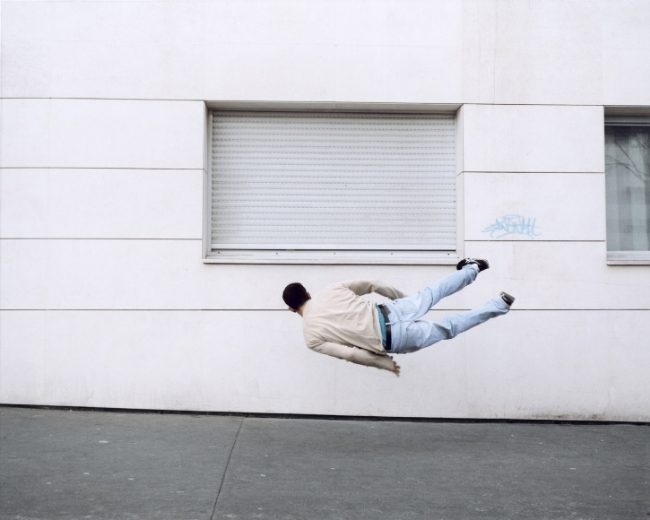Denis Darzacq was born in a good neighborhood in Paris in 1961. He went to a good school, got a good education, started a good job as a press photographer. He signed up with Agence Vu, the elite French photography agency. That probably would have been enough for most people.
But Darzacq branched out into art photography, creating a series called “Ensembles.” This was an almost sociological study of how people interact in public social spaces. Darzacq’s photographs of people meeting each other, talking, hanging out were all done surreptitiously from above, giving the effect of viewing a stage from a high balcony seat.

Then in October of 2005, in a suburb of Paris, a group of teenagers of North African Muslim descent were returning from a soccer match when they saw police officers setting up a roadblock to conduct ID checks. Wanting to avoid being questioned (which could take hours while the ID papers were double-checked) and wanting to get home in time to break their Ramadan fast, the teens ran away. The police, seeing young men running away, pursued them. Three of them clambered over a fence into an electrical relay substation; two of them died of electrical shock when they ventured too close to a transformer.
Rumors about the deaths quickly spread through the neighborhood, whose population is predominantly first and second generation Muslim immigrants. Anger and frustration had been building for years among alienated young Muslims in France because of high unemployment, accusations of police harassment, claims of housing discrimination based on religion. The deaths of the two teens sparked a small riot, the first of many. For the next two months France was rocked by increasingly violent rioting between French-Muslim youths and the police.

That unrest was the inspiration for Darzacq’s award-winning photo-series, La Chute (The Fall). In that eruption of violence, he saw echoes of the same sort of rage that had led to the attacks against the World Trade Center on September 11, 2001. That led him to remember the horrific images he’d seen of people leaping from the burning buildings. He found an eerie parallel between the people leaping/falling to their deaths and the people rioting; both were making ugly choices because they had no hope. Darzacq saw an entire generation in free fall, about to smash into the pavement.
“When the social elevator is broken down, it is necessary to learn to bounce.”
In his explorations of the poorer, immigrant neighborhoods of Paris he’d seen hip-hop break-dancers at work, and had taken their photographs informally. Those photographs of kids leaping and contorting their bodies converged with his thoughts about civil unrest and alienation and bodies falling. He conceived the idea of hiring some of those dancers as models for a new series of images.
He asked the dancers to work out new moves–moves that wouldn’t look like dance moves. Darzacq scouted out the “most banal modern architecture” in Paris for backgrounds. He took the dancers to cheap market stalls to buy mundane clothing so they would have a generic look; he didn’t want the images to be recognizable as individuals. He told them he wanted them to be expressionless in the photos; no grimacing, no frowning, no scowling.
Finally he had them hurl themselves into the air and smash themselves against the pavement, over and over again, taking a single shot each time.

These photographs are not the product of photoshop or other digital manipulation. They were taken with a manual camera. The images are startling enough, though, that for many people the first response on seeing them is to wonder “How did he DO that?” That the viewer’s initial response is to wonder about the technique instead of the content almost certainly makes the photographs less effective. But they remain compelling. Indeed, the sixteen photographs in La Chute won first prize in the Arts and Entertainment: Stories category of World Press Photo contest.
Even a viewer who knows nothing about what happened in France during those two months of 2005 will understand the notion of a generation in freefall. Alienation is universal. Hopelessness and rage exist everywhere. And somewhere, someplace somebody is always about to smash into the pavement.
